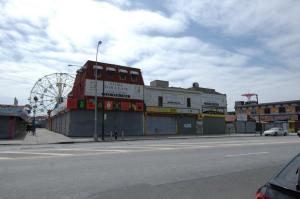
On Palm Sunday, the Coney Island Cyclone will clank, sputter and tilt into motion, careening its shrieking cargo around clattering curves and ushering in the new season. The whole neighborhood, rusty gears and all, will churn into motion, the same way it has for years. And like every other season in recent memory, the death of Coney Island—foretold for decades by disgruntled developers, reporters and Mermaid Paraders alike—will be deferred to a later date.
But this year the quiet sigh of recognition that comes each spring, that, yes, the place is still there, after all, is different. This summer, the first new rides will appear since the dismantling of Astroland, and with them, many have declared the coming of a new Coney Island, a Coney Island risen, reborn. A few have even called off the decades-old ritual of promising the near and certain end.
New Yorkers forecast the deaths of neighborhoods, scenes, avenues, authenticity. But the Coney Island doomsday prophecy has become a rite all its own. Coney Island, it long seemed, was always just a season away from swift and utter extinction. Carny barkers and snake charmers were a dart toss from the unemployment line. Bold new development plans were perpetually spelling apocalyptic doom. And through it all, Coney Island groaned on.
Because as much as New Yorkers like to eulogize its corners, the city won’t stay still long enough. The unchanging law of eight million is relentless, unceasing change itself. On Coney Island, history is not a tale of reinvention so much as absolute obliteration and genesis. A pronouncement from The New York Times: “Coney Island is regenerated, and almost every trace of Old Coney Island has been wiped out. Frankfurters, peanuts, and popcorn were among the few things left to represent the place as it was in the old days.” That was 1904.
But even Coney Island’s convulsive trajectory, its shriek-inducing drops and hairpin turns, has left behind a few embalmed bits of history, which every now and then kick up the dust of dime museums come and gone. Among them is the Grashorn Building, a largely unremarkable structure on Surf Avenue. Once home to Grashorn’s Hardware, the building stands as the oldest remaining relic of early Coney Island’s slapdash wonderland. In its heyday, the hardware store churned out bolts, nails, rivets and enough timber to prop up legions of gaudily painted sham worlds.
More recently, Joe Sitt acquired the site, a small speck on the acres of Coney Island he bought up over the last decade for a glittering development called Dreamland, a proposed Vegas-style playground—part resort, part retail extravaganza—that never actually materialized. Though after a prolonged and lengthy battle, he sold most of his land to the city in late 2009, Mr. Sitt still retains some properties, including the Grashorn Building, vacant up until now.
Last month, Texan showman John Strong III announced plans to relocate his freak show to the former hardware shop, which he will lease from Mr. Sitt. This season will be the showman’s second on Coney Island, and like last year, he has been vocal in his challenge to sideshow rival and unofficial Coney Island mayor Dick Zigun, who was critical of Mr. Sitt in his long standoff with the official New York mayor. Though the standoff is over, the carny fighting words perhaps hint at the uncertainty that persists over the island’s future and the tension between public and private enterprise that has hung over its history.
This summer’s heralded Luna Park, contracted out by the city to multinational park operator Zamperla, is a temporary stand-in for the city’s ultimate revitalization, which could take years, even decades to be realized. In the meantime, it’s not so much a new Coney Island, a regenerated Coney Island, or a Coney Island back from the dead. It’s a Coney Island with a few things new and many things the same. The frankfurters, peanuts, and popcorn are still there.
BY THE MID-19TH CENTURY, Coney Island was a sanctuary for fugitives fleeing Manhattan -high-class fugitives seeking an exclusive enclave as well as fugitives of a more illicit sort. Manhattan elites set up a refined resort on the peninsula’s east end, drawn to its isolated swaths of nature where the only population density was a profusion of rabbits. Meanwhile, on the west end, a criminal element gathered to escape the oversight and regulation of the city. From the start, the island oscillated between extremes—at once a “Sodom by the Sea” and a highbrow “City of Light”—with moral and class-based tensions not always easy to disentangle.



